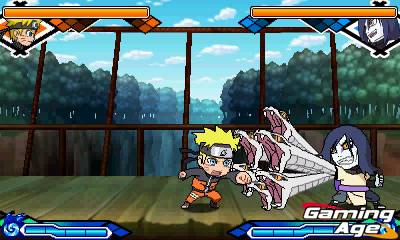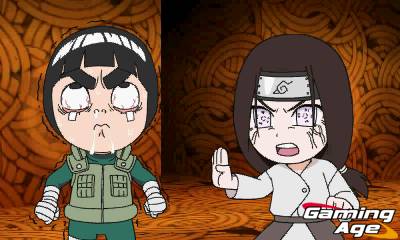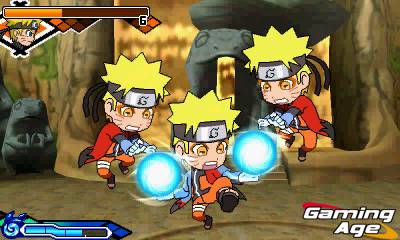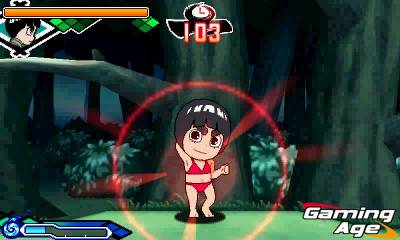Publisher: Namco Bandai
Developer: Inti Creates
Medium: Cartridge
Players: 1
Online: No
ESRB: E10
While Naruto fans are obsessing over the roster of Naruto Shippuden: Ultimate Ninja Storm 3 right now, I?m going to attempt to pull a little attention over to the other Naruto game released last week. Naruto: Powerful Shippuden is a 2D brawler developed by Inti Creates, Japanese developers responsible for a whole lot of portable Mega Man games, and a bunch of other stuff that you probably never played. Powerful Shippuden features two complete storylines, one that revolves around the actual anime series, while the second acts as a side story featuring the loveably awkward Rock Lee.
I?m not going to go wild and call this a great brawler, but it certainly shaped up to be better than I was expecting. The big head, small body art style used here commonly referred to as Chibi belies a surprising level of difficulty and content. I was ready to pass this off a simple kid friendly cash-in for portable owners, but what I found was an often humorous take on the well-tread Naruto franchise, with passable combat and a gameplay structure built for the portable player.
 As mentioned above, the game is split into two halves, featuring Naruto and Rock Lee. The Naruto portion of the game picks up at the beginning of the Shippuden arc, and ends just a bit past the final fight with Pain. It doesn?t cover the same ground as Ultimate Ninja Storm 3, and leaves out a lot of material, focusing instead on key moments and battles. The roster isn?t as expansive as UNS3 either, but you do get a lot of fan favorites that act as support characters, which can be called in to use special moves and abilities.
As mentioned above, the game is split into two halves, featuring Naruto and Rock Lee. The Naruto portion of the game picks up at the beginning of the Shippuden arc, and ends just a bit past the final fight with Pain. It doesn?t cover the same ground as Ultimate Ninja Storm 3, and leaves out a lot of material, focusing instead on key moments and battles. The roster isn?t as expansive as UNS3 either, but you do get a lot of fan favorites that act as support characters, which can be called in to use special moves and abilities.
The Rock Lee storyline is easily the best, featuring an oddball side story that focuses on Rock Lee, Neji, Tenten, and Guy. There?s some legitimately funny sequences and dialogue, and while everything on the story side is delivered via still images, the artwork really capitalizes on Lee?s antics and personality from the series. There?s a lot of general humor that works regardless of how familiar you are with the anime, but it?s definitely better if you?re familiar with the character quirks that are amped up here.
 Naruto: Powerful Shippuden divides these storylines into two different maps for each character. From the map screen you?ll take on various missions that unlock and branch out once the previous missions have been finished. Each mission only lasts about 2 to 5 minutes, with a handful going under or over that estimate by a little. These quick bursts of gameplay fit the portable format well, allowing you some semblance of progression without devoting large chunks of time without some breathing room between stages.
Naruto: Powerful Shippuden divides these storylines into two different maps for each character. From the map screen you?ll take on various missions that unlock and branch out once the previous missions have been finished. Each mission only lasts about 2 to 5 minutes, with a handful going under or over that estimate by a little. These quick bursts of gameplay fit the portable format well, allowing you some semblance of progression without devoting large chunks of time without some breathing room between stages.
The majority of the missions in Naruto: Powerful Shippuden are focused on combat, but there is a decent amount of variety found in the mission types early on. The only drawback is that once you hit the halfway point, you?ll have seen most of the missions offered, enough so that the second half of the game feels like a retread of previous content, just harder than before.
 Combat is also the most fleshed out and fully functional aspect of the gameplay. Both Naruto and Rock Lee come with a small set of moves that can be chained together with face button prompts like any other brawler or fighter. The initial combo strings are simple enough that it feels a bit bland at first. But you?ll slowly build upon the basics with other mechanics, introducing special moves or jutsu, equipment that can inflict status effects like poison or confusion, and so on. There are customization options that open up as you advance, making this a deeper experience than the initial impression gives off.
Combat is also the most fleshed out and fully functional aspect of the gameplay. Both Naruto and Rock Lee come with a small set of moves that can be chained together with face button prompts like any other brawler or fighter. The initial combo strings are simple enough that it feels a bit bland at first. But you?ll slowly build upon the basics with other mechanics, introducing special moves or jutsu, equipment that can inflict status effects like poison or confusion, and so on. There are customization options that open up as you advance, making this a deeper experience than the initial impression gives off.
On the negative side there are a few things worth mentioning. The standard enemy design is woefully lacking and way too repetitive for the number of missions you?ll take on. Named characters look great here, and the animation used to model these sprites is surprisingly fluid. But the run of the mill guys that you slug it out with over and over again could have used a little more work. You?ll often battle against enemies like wolves, frogs, birds and rogue ninja. There?s a couple palette swaps tossed in for all four, which designate what special ability or attack they are likely to use. But by and large the enemy design feels lazy, especially in comparison to the rest of the cast.
 Stage design is also sorely lacking. While you?ll take on dozens and dozens of missions with different parameters, you?ll see the same locales used again and again. There?s a forest area that you can run through and get some verticality by jumping up on branches, along with an indoor area that usually consists of hallway and single rooms accessible by doors. Some stages consist of a single screen area, or two screens, and generally share the same backdrop. There?s just not enough variety present for the number of missions you?ll tackle here.
Stage design is also sorely lacking. While you?ll take on dozens and dozens of missions with different parameters, you?ll see the same locales used again and again. There?s a forest area that you can run through and get some verticality by jumping up on branches, along with an indoor area that usually consists of hallway and single rooms accessible by doors. Some stages consist of a single screen area, or two screens, and generally share the same backdrop. There?s just not enough variety present for the number of missions you?ll tackle here.
Naruto: Powerful Shippuden is at its best when you?re engaged in the one vs. one boss fights. These encounters focus almost entirely on combat, outside of the really annoying Deidara battle. For the most part they allow the combat side of the game to shine, and I?d almost prefer this to be the focus if a sequel is ever developed. Max out the roster options, give me a couple of platforming inspired missions with a little more variety, and toss in a boss fight every fourth mission or so. The combat is polished enough to sustain the formula, and I think you?ll agree that the fights you get to play through here will be the most fun you?ll have with Powerful Shippuden.
I definitely think Naruto: Powerful Shippuden is worth a look, so don?t let that cutesy art style fool you. The combat mechanics are solid, it?s built in a way that is perfect for portables, and has enough content to keep you engaged with it for a while. It?s only real negatives are an over-reliance on repetitious missions, but if you?re up for some mindless fun you?ll still enjoy your time spent. It?s a more inventive take than you usually see for licensed anime titles, and smartly evolves past the standard, overwrought storyline retreads typically used.

